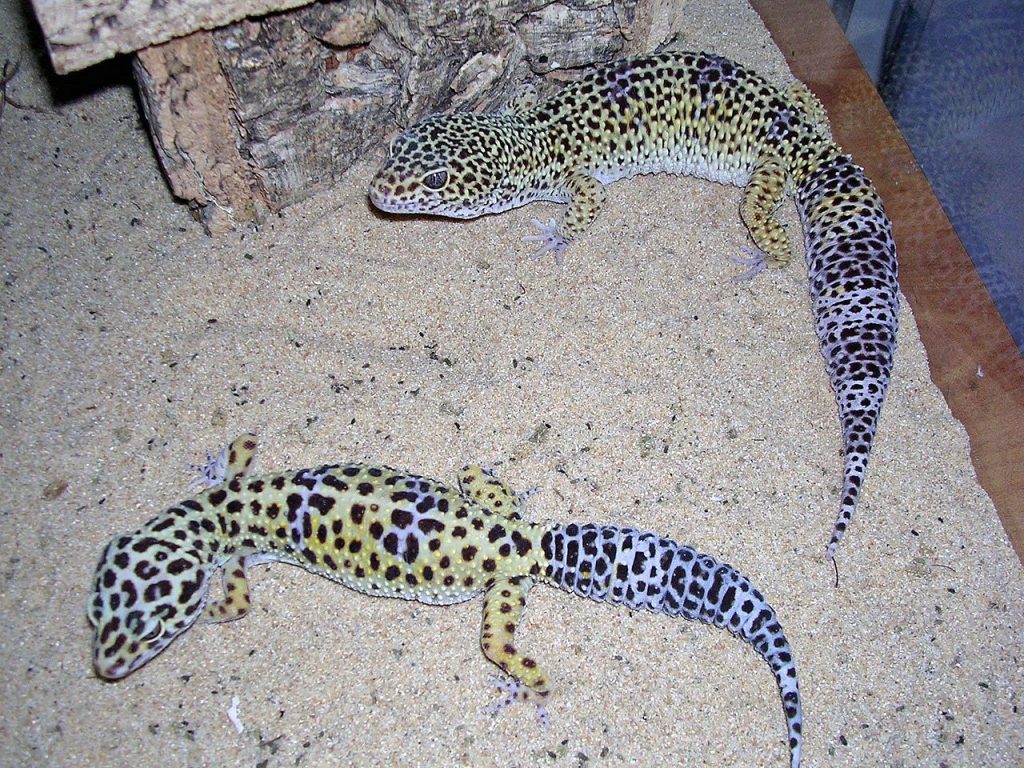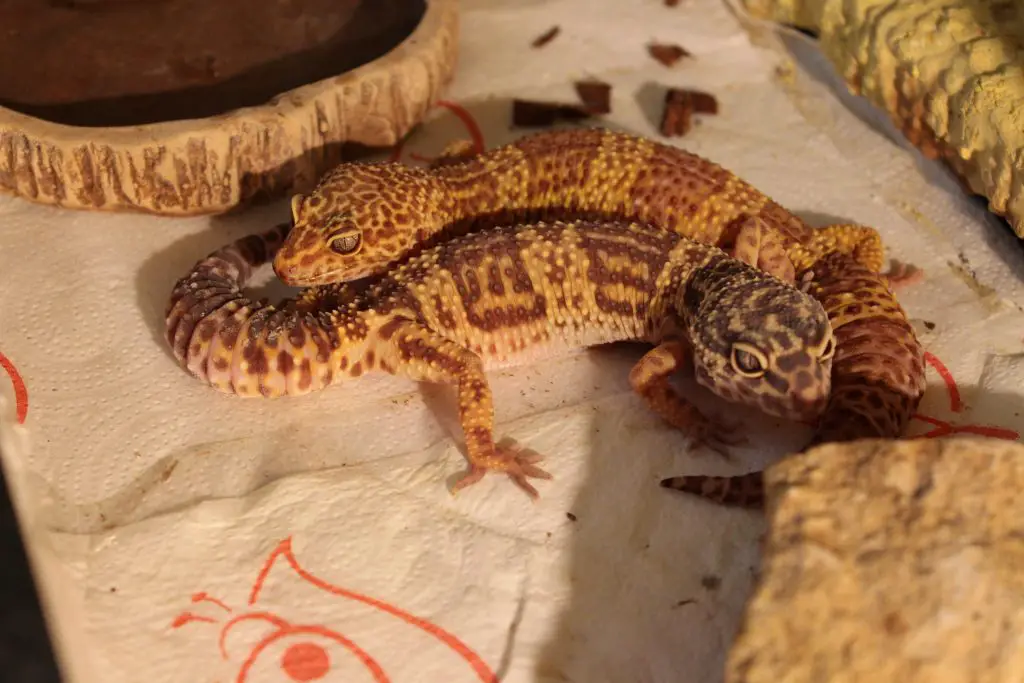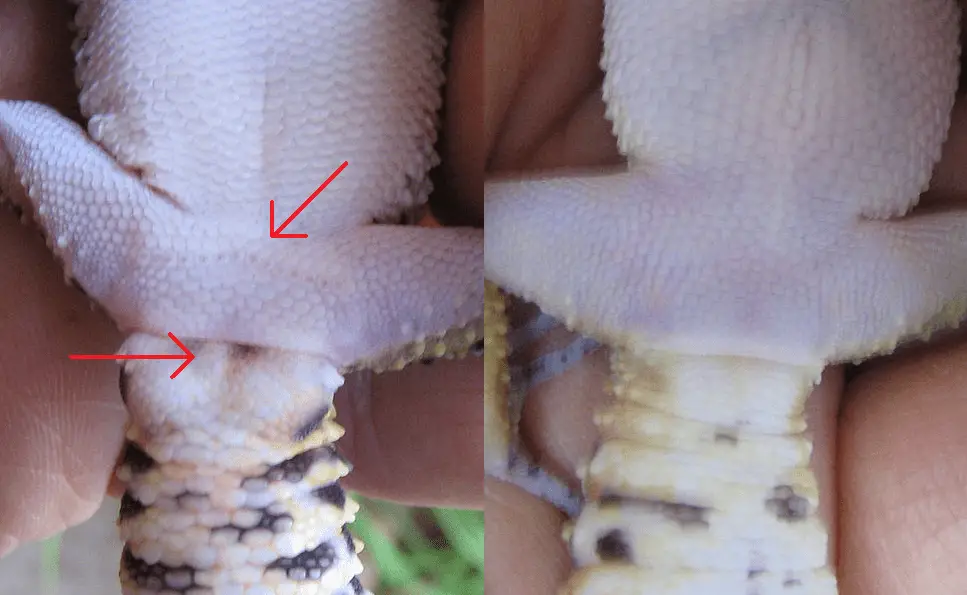Leopard geckos are a popular pet choice, and for good reason – they’re cute, docile, and easy to take care of. But one question that often comes up is whether or not leopard geckos can live together.
In this comprehensive guide, we will answer that question and provide all the information you need to successfully house multiple leopard geckos together!
- Key Takeaway
- Can You Keep Multiple Male Leopard Geckos Together?
- Can You Keep Multiple Female Leopard Geckos Together?
- How Many Leopard Geckos Can Live Together?
- The Pros and Cons of Keeping Multiple Leopard Geckos Together
- How To Tell If My Leopard Gecko Is Male or Female?
- FAQs
- Q: What happens if leopard geckos are housed together?
- Q: Can male and female leopard geckos be housed together?
- Q: How much space do leopard geckos need?
- Q: Do leopard geckos need a heat source?
- Q: What temperature range do leopard geckos need?
- Q: What should I feed my leopard gecko?
- Q: How often should I feed my leopard gecko?
- Q: Can leopard geckos eat fruits and vegetables?
- Q: How often should I clean my leopard gecko’s enclosure?
- In Conclusion
Key Takeaway
- Leopard Geckos can live together under specific conditions, with two females generally able to cohabitate peacefully and a male and female pair possible for breeding purposes, but housing two males together is not recommended due to their territorial nature and potential for conflict.
- Multiple male Leopard Geckos should not be kept together due to their territorial nature, which can lead to aggressive behavior and fights.
- While it’s possible for multiple female Leopard Geckos to coexist in the same enclosure under the right conditions, it can be risky due to their solitary and territorial nature, and care must be taken to prevent potential stress or conflict.
- Typically, a group of Leopard Geckos consists of one male and multiple females, although this should be done carefully to avoid stress and conflict, and males should never be housed together due to their territorial nature.
Can You Keep Multiple Male Leopard Geckos Together?

Keeping multiple male Leopard Geckos together in the same enclosure is a pretty big no-no. It’s important to understand that Leopard Geckos are territorial animals.
This means that they will naturally compete with each other for space and resources. If you house more than one male leopard gecko together, there is a good chance that they will eventually fight – sometimes to the death.
When it comes to housing multiple male Leopard Geckos, the size of the tank really doesn’t matter because you shouldn’t do it in the first place. Even if you get a 20-gallon or a 40-gallon tank, the male Leopard Geckos will still cross their paths and fight.
Male Leopard Geckos tend to be more territorial and dominant towards each other. Keeping more than one male Leopard Gecko in the same enclosure will pretty much always result in them fighting or stressing each other out to the point that one is injured or killed, or both are killed if they manage to injure each other enough.
They can fight quickly, and you definitely do not want to risk this. You will end up with Geckos that are missing toes, full of wounds and scars.
Can You Keep Multiple Female Leopard Geckos Together?

It is possible to keep multiple female Leopard Geckos in the same enclosure, but it’s risky. Depending on their attitudes, some female Leopard Geckos simply are not going to want to get along with other geckos. You will have to monitor them and see how they react to each other.
If you keep two female Leopard Geckos in the same enclosure and you see them ”cuddling”, you have to separate them because this is a sign of dominance.
The step you’re going to have to take is actually to see if these two females are going to get along. This by itself is risky because you are still putting them together. And even if you’re monitoring them, something can happen as soon as you’re done monitoring them. They’re animals and they can just change their mind.
There’s no guarantee that two female Leopard Geckos are gonna get along. This means that you can’t just go out, buy two female Leopard Geckos, and hope that they get along. Because if they don’t, they’re gonna have to be separate meaning you’ll need a second enclosure, perfectly set up and ready to go.
Each Leopard Gecko requires at least three hiding places. But because you’re gonna have two geckos, that means you might need six hiding places. It’s gonna be kind of hard to cram six things into an enclosure. But, that’s ideally what you’re going to be doing if you have two Leopard Geckos together.
How Many Leopard Geckos Can Live Together?
Male Leopard Geckos can’t live together because they are very territorial and will end up fighting all the time, regardless of the size of the enclosure. However, female Leopard Geckos have a higher chance to get along together and you can keep up to three reptiles in the same enclosure. But, you can’t just buy three females and expect them to get together as sometimes it just won’t work.
However, keeping three female Leopard Geckos in the same enclosure is not an easy task. Each Leopard Gecko requires around 20 gallons of space for it to be happy and healthy. So, keeping three Leopard Geckos will require at least a 75-gallon tank. If you need a large tank, you can get one on amazon.com.
Next, each Leopard Gecko requires three hiding places: One in the warm part of the enclosure, one in the cold part of the enclosure, and one in the wet part of the enclosure where they will shed. Housing three geckos will require a total of 9 hiding spots.
In fact, you might not need three shedding spots as they will probably not end up shedding at the same time. But still, adding so many hiding spots can be a hustle.
Leopard Geckos thrive in temperatures between 70 and 80 degrees Fahrenheit. Depending on the size of the enclosure, you might require more than one heating source. It is very important to keep the temperature steady or the Leopard Geckos can get sick or die says Go Herping.
The Pros and Cons of Keeping Multiple Leopard Geckos Together
There are a lot of pros and cons when it comes to keeping multiple Leopard Geckos together. Before you decide to house multiple Leopard Geckos together, it is best if you go through this list.
Pros of keeping multiple Leopard Geckos together
1. You will save space
When keeping multiple Leopard Geckos together (if they get along, of course), you will save space because you will only need one tank. This is ideal if you don’t have a lot of free space in your room.
2. No need for multiple heating sources
Leopard Geckos can’t generate heat with their bodies because they are cold-blooded animals. You will need to provide a heating source. The good thing when keeping multiple Leopard Geckos in the same enclosure is that you don’t have to buy multiple heating sources.
3. Less cleaning
If you hate cleaning, then this is probably the best reason why you should your geckos in the same tank. By doing so, you will have fewer tanks to clean.
Cons of keeping multiple Leopard Geckos together
1. Not all Leopard Geckos will appreciate the company
It is practically impossible to house two or more male Leopard Geckos because they will fight all the time. The same goes for the female Leopard Geckos. It takes time and effort to actually see whether two female geckos will get along. But even then, they can just change their minds one day and fight.
2. You will need a big tank to fit a lot of hiding places
Each individual Leopard Gecko requires at least three hiding places: One hide in the warmer part of the enclosure, one hide in the cooler part of the enclosure, and then a third hide which you’d call a humidity hide or a moist box, and this will basically be where the gecko can go and easily shed.
It is hard to cram so many hiding places into an enclosure. Now, you could probably get by with just one humidity hide ’cause chances are, they won’t probably into a shed in the time. But doing so could be considered cutting corners with your husbandry and that’s not the smartest thing to do.
3. Buying a huge tank
A rule of thumb is that one Leopard Gecko requires between 15 and 20-gallon tanks. So, depending on how many Leopard Geckos are you housing, you are going to buy a huge tank which is pricey.
4. Can’t really monitor the feeding
Each Leopard Gecko has a feeding area or a spot. So, let’s say you keep two female Leopard Geckos in the same enclosure. When it’s time for a meal, you will have to actually monitor and make sure that both of the geckos ate and not just one.
Sometimes, one Leopard Gecko will eat both meals which will result in weight loss in the other gecko. You can’t really tell how much each gecko ate unless you sit there and watch.
5. Can’t monitor their stool
The poop is a great way to monitor the health of your Leopard Geckos. Through poop, you are able to tell if the Leopard Gecko is sick. When you are cleaning the tank and you have multiple Leopard Geckos, if you notice a poop that has weird color, is mushy and does not look too good, you can’t actually tell which gecko is it coming from.
6. One Leopard Gecko can make the other sick
If one of your Leopard Geckos gets sick with something contagious, they can end up getting the other geckos sick. You will end up with double the problems if the sickness spreads across the entire enclosure.
How To Tell If My Leopard Gecko Is Male or Female?

Leopard geckos are one of the easiest lizards to gender. Males have a large bulge at the base of their tail and females do not. You can also feel along the vent (the underside of the lizard near the cloaca) to determine sex; males will have two bumps while females will only have one. If you’re still not sure, take your gecko to a herpetologist or other qualified individual who can help you out!
Actually, there are several ways to identify a male leopard gecko. One way is to look at the size of the animal. Male leopard geckos are typically larger than females.
Another way to identify a male leopard gecko is by looking at the patterns on its body. Male leopard geckos usually have more pronounced patterns than females.
Finally, you can also try to look at the behavior of the animal. Male leopard geckos are often more active and aggressive than females. If you’re still not sure, you can always ask a professional for help.
FAQs
Q: What happens if leopard geckos are housed together?
A: If leopard geckos are housed together, they may fight over resources such as food, hiding spots, and territory. This can result in injuries or stress for the geckos. It is best to provide each leopard gecko with its own separate enclosure.
Q: Can male and female leopard geckos be housed together?
A: While it is possible to house a male and a female leopard gecko together, it is important to be cautious. Female leopard geckos can be aggressive towards males, especially during breeding season. It is recommended to monitor their behavior closely and provide ample space and hiding spots.
Q: How much space do leopard geckos need?
A: Leopard geckos require a minimum of a 10-gallon tank as their primary enclosure. However, providing a larger tank or vivarium can greatly benefit their well-being. The more space you can provide, the better.
Q: Do leopard geckos need a heat source?
A: Yes, leopard geckos require a heat source to maintain their body temperature. A heat mat or an under-tank heater can be used to create a warm area in the enclosure, while a thermostat should be used to regulate the temperature.
Q: What temperature range do leopard geckos need?
A: The basking spot for a leopard gecko should be around 88-92°F (31-33°C). The ambient temperature in the enclosure should range between 75-85°F (24-29°C). It is important to provide a temperature gradient by having a cooler area in the enclosure as well.
Q: What should I feed my leopard gecko?
A: Leopard geckos are insectivores, meaning they primarily eat insects. Their diet should consist of appropriately sized live insects such as crickets, mealworms, and dubia roaches. It is also important to provide a calcium and vitamin D3 supplement to ensure proper nutrition.
Q: How often should I feed my leopard gecko?
A: Adult leopard geckos should be fed every 2-3 days, while juveniles and hatchlings may require more frequent feedings. It is important to provide appropriately sized food items and monitor your gecko’s weight to ensure they are receiving proper nutrition.
Q: Can leopard geckos eat fruits and vegetables?
A: While leopard geckos are primarily insectivores, they do not have the ability to digest fruits and vegetables properly. Their diet should consist mainly of live insects and occasional supplementation with calcium and vitamin D3.
Q: How often should I clean my leopard gecko’s enclosure?
A: It is important to regularly clean your leopard gecko’s enclosure to maintain a healthy and sanitary environment. Spot cleaning should be done daily to remove any waste, and a deep clean with disinfectant should be done on a monthly basis.
In Conclusion
In conclusion, while it’s possible for Leopard Geckos to cohabitate under certain conditions, it’s crucial to note their solitary and territorial nature.
Housing multiple females together or a male with several females can be done with care, but keeping multiple males together is not advised due to potential aggression and conflict.




